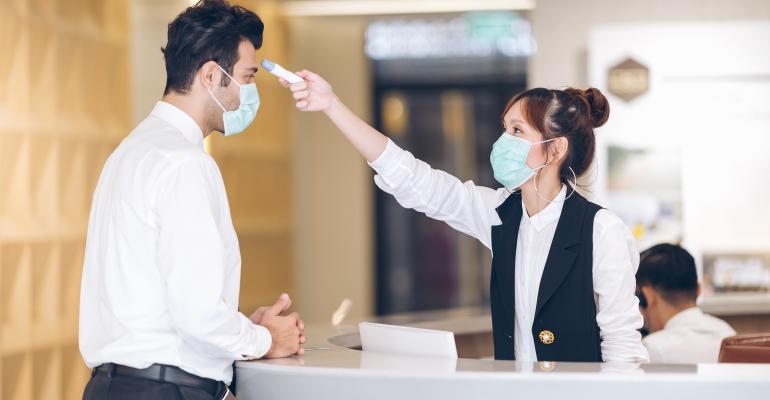Editor’s note: Last week, we detailed how real estate services firm JLL was reopening its own offices. Here we offer an even more in-depth look into best practices.
As many employers invite or require their workers to return to the office, following safety guidelines is crucial to employees’ physical well-being and peace of mind.
Concern for employee safety has prompted most companies to implement social distancing precautions, like moving workstations at least six feet apart and staggering office and remote working schedules, so no more than 30 to 40 percent of the workforce is in the office at any one time.
NREI asked property management, workplace consultant and building design experts for advice on practical measures landlords and tenants can take to prepare for workers’ return.
One solution is to have people working part-time at the office and part-time remotely, says Adam Stoltz, director of consulting at global design firm HOK who has been working closely with clients on office reentry. Data shows that working from home full time doesn’t work for everyone, he notes, so employers should prioritize who returns to the office by job function and employees’ remote working conditions.
To help ensure the returning workers’ safety, Mark Zettl, president of property management for the Americas with real estate services firm JLL, says that property managers or landlords should use ample signage in common areas to encourage building occupants of measures proven effective in combating the spread of the virus, including social distancing, hand washing and mask wearing.
He also advises using plexiglass to create a protective screen for building staff who may have higher than average interpersonal contact with building occupants and visitors, such as guest service personnel.
“Cleaning more often, with the right supplies, and focusing on high-touch areas like bathrooms and elevators is critical to help keep spaces clean,” Zettl adds.
Office common areas need to be cleaned using a disinfectant to kill pathogens, according to Marc Fisher, president/CEO at Inspire Commercial Real Estate, a Maryland-based real estate services and consulting firm, and partner at The Crisis Collaborative, a multi-disciplinary team that provides solutions to help clients manage crises situations. Landlords should provide hand sanitizer and use signage to remind building occupants to apply it before and after touching any surface, like an elevator button or door handle, he notes. Wiping a surface with disinfectant is only effective until the next person touches it.
According to Stoltz, building managers, landlords and tenants need to establish protocols for entering office buildings, such as temperature checks and requiring masks; using space safely when meeting or collaborating with coworkers; and establishing rules for when and where visitors are allowed. Those requirements for entering buildings should be communicated clearly prior to workers or visitors returning, through emails and text messages.
Additionally, Stoltz suggests reorganizing common areas, such as lobbies, to discourage people from congregating. In multitenant buildings landlords should require building occupants to reserve common spaces, such as lounge areas, in order to use them.
Tare generally responsible for the safety measures within their own space and should follow health authority guidelines regarding the number of employees allowed to return to the office, according to Zettl. “However, we’re all in this together and everyone’s health is predicated on the whole building being safe,” he notes, adding that communication between tenants and management is crucial to keeping everyone safe.
Fisher suggests that tenants create separate walkways through offices using a clockwise rotation or directional arrows so people don’t pass each other too closely, and designate different stairwells for up and down traffic when viable.
While there needs to be at least six feet of space between workers, Stoltz says he doesn’t recommend using plexiglass for workstations. “This is just one more place that would need to be cleaned.”
He does suggest that landlords consider installing motion-sensor lighting and other technology that makes operating conference room equipment touchless.
Overall, offices seem headed toward de-densification, notes Zettl. “It’s possible the open office concept that was so popular over the last several years will give way to something that more closely resembles the office set-ups we were used to seeing in the early 2000s.”
Landlords and tenants will also likely adopt and integrate novel technologies to keep workers safe and healthy, as well as improve efficiencies, according to Zettl. He cites two new innovative technologies as examples: a cellphone app that allows workers to enter an office touchlessly and sensor technology that tracks movements of occupants to let management know when a space needs to be cleaned or may be too crowded.
Fisher stresses that preparing a building that has been unoccupied for several months for returning workers must go much deeper than surface cleaning and suggests that property managers seek advice from virologists or biologists.
For example, potable water systems need to be flushed with chlorine to break up bacteria-laden biofilm that forms in stagnant water in pipes that have not been used for an extended period. Likewise, returning tenants need to flush soda machines and ice makers in refrigerators before using them for the same reason. Stoltz also notes that coffee machines and office kitchens and break areas unused for several months will have a buildup of bacteria.
The Centers for Disease Control (CDC) also recommends restarting HVAC systems according guidelines provided by ASHRAE Standard180-2018; increasing circulation of outdoor air by opening windows and doors and using fans; and evaluating building mechanical and life safety systems, checking for hazards associated with a prolonged building shutdown, such as mold growth and pests. Any of those issues need to be remediated before tenants return.
Kaufman admits that drawing outside air will set back energy usage reduction goals, but it is the better operational choice for now. He also suggests more frequent HVAC filter changes and notes that some buildings are deploying UV lighting to disinfect surfaces.





